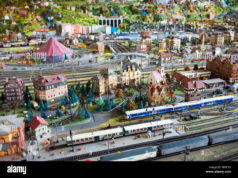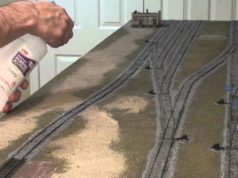You have your track laid and you’re running your train, now what? Model railroading is about more than just trains and track. It’s about creating a miniature world and the joy you get from watching your trains run through it.
Give your imaginary passengers some scenery to look at. This is what brings your entire layout to life, and makes it more interesting.
Whether you’re a beginner model railroader or a veteran, scenery kits are a great way to get started, and to get the creative juices flowing. Using kits shortens the amount of time spent from taking it out of the box, to putting it on your layout to enjoy. It’s a way of getting a big benefit from just a little amount of work. And if you don’t want to do any work at all, there are also kits that are pre-assembled to go from the box straight to your layout.
The creation and addition of railroading scenery and structures are only one of the many aspects involved in the fascinating hobby of model railroading that is open to a great deal of creativity and imagination. A model railroad display does not come to life until it is jolted into existence by the scenery. It’s amazing what a couple of simple scenery elements can do to enhance the realism of even the most basic railroad display.
But before you go buying all kinds of scenery items, you have to have a plan. Just like you made a plan for your track layout, you need one for your scenery. What is the terrain going to be like? Are you going to make mountains, grassy hills, prairie farmland, or forests? Do you want an urban area with tall buildings, or a suburban area with split level housing and white picket fences? You should have somewhat of an idea of how the finished product will look before you buy anything. It is ultimately your layout, and you can do whatever makes you happy, but it is recommended practice to have a unified look among the whole layout.
One of the best things about model railroading is that as you grow in the knowledge of skills you develop, your layout will grow with you. Starting off with kits is just the beginning, there’s also kitbashing, where you take a kit or pieces of multiple kits and make your own creation. Then there’s scratchbuilding, just as the name suggests, where you build completely from scratch, nothing pre-manufactured.
Building kits are made from a variety of materials, so you won’t have any problem finding one that’s right for you. Plastic is the most common material used, and there’s even a whole line of building kits called Plasticville from Bachmann Trains. There are also building kits made from wood, resin, and cardstock. One is not better than the other, it all comes down to your preference. I suggest you take a look at all of them, then decide what you think works best for your layout.
The same thing goes for scenery too. Some modelers use small twigs for trees, real dirt and sand, and small rocks. Woodland Scenics specializes in scenery for model railroaders. They have scene kits that recreate specific scenes you may want to put on your layout. Just as with the building kits, take a look at your options and then make a decision.
10 Tips for Realistic Model Railroading Scenery Design
Here are some ideas to help you design the scenery and structures for your own model railroading layout.
- Passenger Cars – Model passenger cars are more realistic looking when they contain people. It may require a bit of effort for some models such as disassembling a rail car, for example, but it makes an incredible difference in the real life appeal of your scenery.
- Timeline – Keep your scenery additions specific to the era of your model layout. If your railroad is designed to portray the roaring 20’s, a 1957 Chevy would be out-of-place and inappropriate in the layout.
- Consistent Scale – It may be tempting to purchase structures and accessories on sale that are not in your particular model railroad scale. This should be avoided, however, because the best model railroad designs keep everything in the correct scale for uniformity of design.
- Scratch-building – It is not necessary to purchase all of your structure and scenery items. Some of the best model railroad scenery designs include many additions that are found or created at home. Using actual tree branches, grass, leaves, sand, dirt, or bits of hay can add a very realistic and authentic touch to your railroad design.
- People Population – Mix and match scenery items, especially an item such as people. While you want to place figurines in your layout that are specific to the era you are attempting to achieve, don’t purchase all of them from the same manufacturer. Add variety and a more realistic touch by mixing and matching different figurines from various suppliers.
- Weathering – Don’t hesitate to rough up your structures and accessory buildings a bit for a more authentic look. You don’t want every building in your design to look like it just came from the model train store.
- If you want to achieve an old worn building or barn look, scratch and gouge the surface a little bit using small tools or sandpaper. Then apply hobby paint mixed with paint thinner. For a metal building you might use blue, black, and gray. For an old barn, you might use shades of brown, black, and tan. Before the paint dries fully, wipe some areas off with a rag. Apply extra paint in the scratched and gouged recesses you created with the tools or sandpaper and don’t wipe these areas off.
- Interior Design – Decorate the interiors of some of your structures. Thin paper can be used for drawing curtains or blinds. Fabric scraps can also be used as makeshift curtains on window interiors by gluing the fabric to paper or cardboard and applying to the window surface.
- Advertisements – Make your own “era specific” advertising billboards and signs. You can find images online, in magazines, and in old newspapers and scan and resize them. Then glue or decoupage them to flat surfaces, add legs for standing them up, and place throughout your railroad display.
- Animals – Animal figurines are a great addition to model train scenery. The animals you choose, of course, are dependent on your specific model theme and era. If you have a western theme, for example, horses, cows, and chickens would be appropriate. If you have a scrap or railroad yard theme, some stray dogs and cats would fit in well.
- Tis the Season – Some hobby train enthusiasts modify their layouts according to the seasons. You can string Christmas lights and add snow for winter. Pumpkins on porches are a nice touch for Halloween along with some trick-or-treaters and a haunted cemetery.
One of the most important points to remember about your model railroad scenery is that you are limited only by your own imagination and creativity. While the track, the locomotive, and the rolling stock are essential components in your set up, the entire display does not come to life until you breathe air into it with lifelike scenery elements that make your individual model train layout unique. All aboard!






